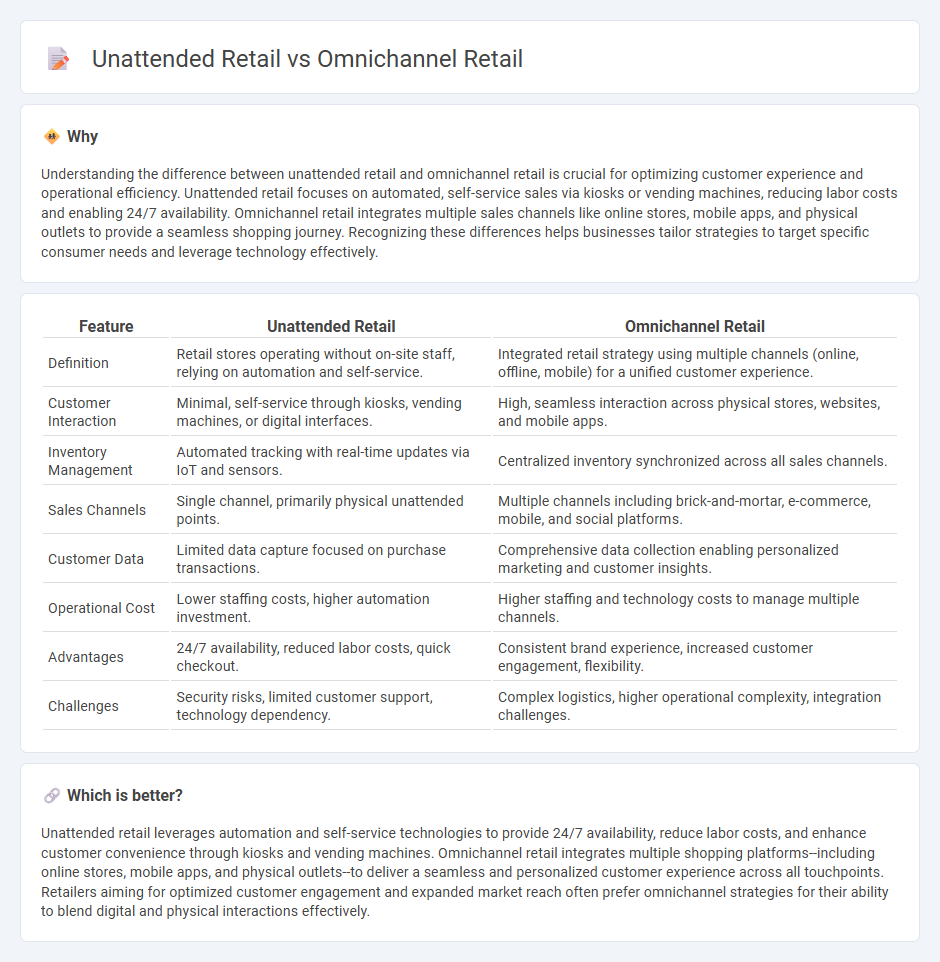
Unattended retail leverages automated kiosks and vending machines to offer seamless, 24/7 shopping experiences without the need for on-site staff, focusing on convenience and efficiency through technology such as RFID and IoT sensors. Omnichannel retail integrates multiple shopping platforms--physical stores, online shops, mobile apps, and social media--to create a unified customer experience, emphasizing consistent branding and personalized engagement across all touchpoints. Explore the evolving landscape of retail to understand how these models cater to diverse consumer behaviors and preferences.
Why it is important
Understanding the difference between unattended retail and omnichannel retail is crucial for optimizing customer experience and operational efficiency. Unattended retail focuses on automated, self-service sales via kiosks or vending machines, reducing labor costs and enabling 24/7 availability. Omnichannel retail integrates multiple sales channels like online stores, mobile apps, and physical outlets to provide a seamless shopping journey. Recognizing these differences helps businesses tailor strategies to target specific consumer needs and leverage technology effectively.
Comparison Table
| Feature | Unattended Retail | Omnichannel Retail |
|---|---|---|
| Definition | Retail stores operating without on-site staff, relying on automation and self-service. | Integrated retail strategy using multiple channels (online, offline, mobile) for a unified customer experience. |
| Customer Interaction | Minimal, self-service through kiosks, vending machines, or digital interfaces. | High, seamless interaction across physical stores, websites, and mobile apps. |
| Inventory Management | Automated tracking with real-time updates via IoT and sensors. | Centralized inventory synchronized across all sales channels. |
| Sales Channels | Single channel, primarily physical unattended points. | Multiple channels including brick-and-mortar, e-commerce, mobile, and social platforms. |
| Customer Data | Limited data capture focused on purchase transactions. | Comprehensive data collection enabling personalized marketing and customer insights. |
| Operational Cost | Lower staffing costs, higher automation investment. | Higher staffing and technology costs to manage multiple channels. |
| Advantages | 24/7 availability, reduced labor costs, quick checkout. | Consistent brand experience, increased customer engagement, flexibility. |
| Challenges | Security risks, limited customer support, technology dependency. | Complex logistics, higher operational complexity, integration challenges. |
Which is better?
Unattended retail leverages automation and self-service technologies to provide 24/7 availability, reduce labor costs, and enhance customer convenience through kiosks and vending machines. Omnichannel retail integrates multiple shopping platforms--including online stores, mobile apps, and physical outlets--to deliver a seamless and personalized customer experience across all touchpoints. Retailers aiming for optimized customer engagement and expanded market reach often prefer omnichannel strategies for their ability to blend digital and physical interactions effectively.
Connection
Unattended retail leverages automated technology to provide seamless shopping experiences without staff, integrating directly with omnichannel retail strategies that unify online and offline customer interactions. Both models rely on real-time data analytics and inventory management systems to optimize stock availability and personalized marketing across multiple sales channels. This integration enhances customer convenience, reduces operational costs, and strengthens brand consistency throughout the retail ecosystem.
Key Terms
**Omnichannel Retail:**
Omnichannel retail integrates multiple sales channels including physical stores, online platforms, and mobile apps to create a seamless customer experience across touchpoints. It leverages data analytics, personalized marketing, and inventory management to enhance customer engagement and satisfaction. Discover how omnichannel strategies drive sales growth and customer loyalty in modern retail.
Customer Journey
Omnichannel retail seamlessly integrates physical stores, online platforms, and mobile apps to offer a unified and personalized customer journey, enhancing convenience and engagement at every touchpoint. Unattended retail leverages automated kiosks and vending machines, emphasizing speedy transactions and 24/7 accessibility but with limited personalized interaction. Explore the advantages and challenges of each approach to optimize your retail strategy.
Integrated Channels
Omnichannel retail seamlessly integrates physical stores, e-commerce platforms, mobile apps, and social media to deliver a unified shopping experience, enabling customers to switch effortlessly between channels. Unattended retail relies heavily on automated solutions such as vending machines, kiosks, and smart lockers without direct human interaction, focusing on convenience and speed. Explore how integrated channels transform retail strategies and amplify customer engagement.
Source and External Links
What is Omni-Channel Retail? | Salesforce US - Omni-channel retailing is a model where shoppers engage across multiple physical and digital sales channels seamlessly, with their data retained to allow resuming shopping anytime, offering a unified, consistent experience unlike multichannel retail which lacks integration.
What is Omnichannel Retailing? Basics Explained - Magestore - Omnichannel retail integrates all sales channels via centralized data management and omnichannel POS systems, creating a seamless, personalized shopping journey across physical and online platforms.
What Is Omnichannel Retail? How it Works and Examples (2024) - Omnichannel retail is a fully integrated commerce approach providing shoppers a unified experience across all channels, blending physical stores, mobile, social media, and online marketplaces into a seamless and personalized customer journey.
 dowidth.com
dowidth.com